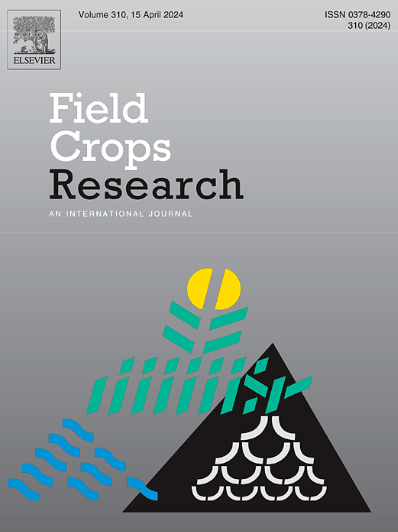Wheat crop models underestimate drought stress in semi-arid and Mediterranean environments
IF 5.6
1区 农林科学
Q1 AGRONOMY
引用次数: 0
Abstract
Under climate change and increasingly extreme weather, projections of water demand and drought stress from process-based crop models can inform risk management and adaptation strategies. Previous studies investigating maize crop models demonstrated considerable error in the simulation of water use, and no similar evaluation of wheat crop models exists. The aims of this study were to (1) evaluate wheat crop models’ performance in reproducing observed daily evapotranspiration (ET) for Mediterranean and semi-arid environments, and (2) identify factors and processes associated with model error and uncertainty. These were assessed with an ensemble of wheat crop models for two experiments, one conducted in Bushland, Texas, USA (three seasons, deficit and full irrigation) and another in Avignon, France (four rainfed seasons) with winter bread and durum wheat, respectively. Models were calibrated with all observed data for crop growth. The model ensemble median underestimated water use in all environments evaluated, suggesting a systematic bias. The relative error in underestimating daily ET was constant across levels of atmospheric evaporative demand; therefore, the absolute error was greater for days with larger evaporative demand. This implies errors in the soil water balance increase more rapidly under high evaporative demand conditions. Using a potential versus reference crop evapotranspiration approach did not explain relative model performance. However, the sensitivity analysis indicated that simulation of atmospheric evaporative demand terms explained much more uncertainty in seasonal water use than terms related to soil depth or root growth. Errors in simulated leaf area index were associated with errors in daily simulated ET, but the relationship varied with the growth stage. Collectively, the results suggest the need to improve simulation of atmospheric ET demand to avoid underestimating projected impacts of drought or required water resource availability for viable production systems.
小麦作物模型低估了半干旱和地中海环境中的干旱胁迫
在气候变化和日益极端的天气下,基于过程的作物模型对水需求和干旱胁迫的预测可以为风险管理和适应战略提供信息。先前对玉米作物模型的研究表明,在水分利用模拟中存在相当大的误差,而对小麦作物模型的类似评估则不存在。本研究的目的是:(1)评估小麦作物模型在再现地中海和半干旱环境下观测到的日蒸散量(ET)方面的性能;(2)确定与模型误差和不确定性相关的因素和过程。通过对两项试验的小麦作物模型进行综合评估,一项试验在美国德克萨斯州布什兰进行(三季,亏缺和充分灌溉),另一项试验在法国阿维尼翁进行(四季旱作),分别使用冬面包和硬粒小麦。模型用所有观测到的作物生长数据进行校准。模型集合的中位数低估了所有评估环境的用水量,表明存在系统偏差。低估日蒸散发的相对误差在不同的大气蒸发需求水平上是恒定的;因此,在蒸发量较大的日子,绝对误差较大。这意味着在高蒸发需要量条件下,土壤水分平衡误差增加得更快。使用潜在蒸散量和参考作物蒸散量方法不能解释模型的相对性能。然而,敏感性分析表明,与土壤深度或根系生长相关的项相比,大气蒸发需求项的模拟更能解释季节用水的不确定性。模拟叶面积指数的误差与日模拟ET的误差相关,但关系随生长阶段的不同而不同。总的来说,这些结果表明需要改进大气ET需求的模拟,以避免低估干旱的预估影响或可行生产系统所需的水资源可用性。
本文章由计算机程序翻译,如有差异,请以英文原文为准。
求助全文
约1分钟内获得全文
求助全文
来源期刊

Field Crops Research
农林科学-农艺学
CiteScore
9.60
自引率
12.10%
发文量
307
审稿时长
46 days
期刊介绍:
Field Crops Research is an international journal publishing scientific articles on:
√ experimental and modelling research at field, farm and landscape levels
on temperate and tropical crops and cropping systems,
with a focus on crop ecology and physiology, agronomy, and plant genetics and breeding.
 求助内容:
求助内容: 应助结果提醒方式:
应助结果提醒方式:


